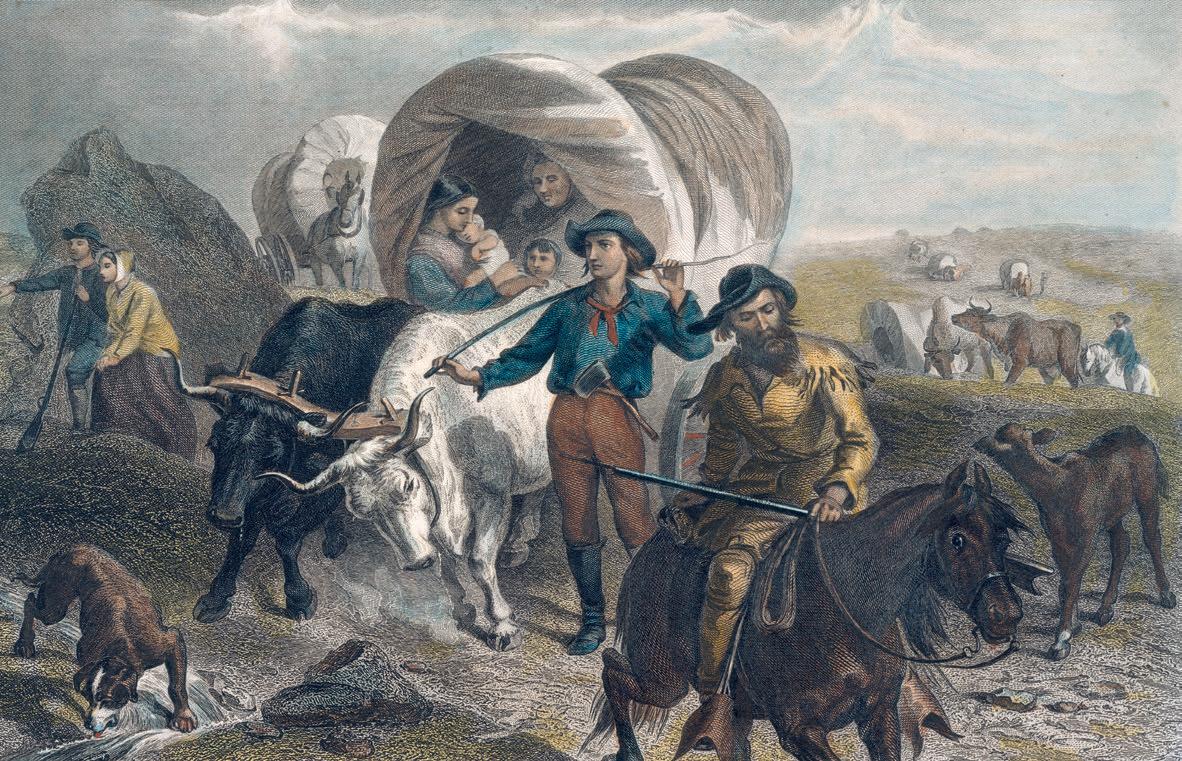
But it was 2,000 miles away through an unknown land. Pulling up roots and moving families and belongings on a difficult and dangerous trip required careful planning. Some families spent a year preparing for the trip.
The journey west began at the Missouri River. Western Missouri cities such as Independence and St. Joseph became bustling “jumping-off” points. Those towns grew into places full of shops and businesses that provided everything pioneers might need—from wagons to livestock and provisions—for their cross-country journey. They also became places where emigrants could gather and meet up.
STURDY WAGONS
Wagons of all types were used, but a smaller version of the Conestoga wagon from the 1700s was especially popular. It was lightweight but sturdy with long, low sides. It usually had a straight bed, making it different from the boat-curved Conestoga. The best wagons were built of hardwood such as hickory, oak, or maple. Hardwoods resisted shrinking in the dry plains air. A light canvas or homespun top stretched over the wagon’s wooden ribs to protect the contents. From a distance, the wagons looked like small ships sailing across the plains. They soon became known as prairie schooners.
At least two teams of oxen were needed to pull a prairie schooner. Two oxen harnessed together with a wooden yoke made a team. Although they were slower than horses or mules, oxen were more reliable and did not have to be unyoked to graze. They also ate prairie grass, which made feeding them easier than horses, who needed hay in their diets.
This story is from the October 2023 edition of Cobblestone American History Magazine for Kids.
Start your 7-day Magzter GOLD free trial to access thousands of curated premium stories, and 9,000+ magazines and newspapers.
Already a subscriber ? Sign In
This story is from the October 2023 edition of Cobblestone American History Magazine for Kids.
Start your 7-day Magzter GOLD free trial to access thousands of curated premium stories, and 9,000+ magazines and newspapers.
Already a subscriber? Sign In

Eye in the Sky
An interview with Joe Piotrowski

Airborne Animals
Humans have taken to the skies in balloons, gliders, and airplanes-but we're not alone among the clouds. Animals of all sorts have evolved to harness wind power.

TAKING OFF
The Wright brothers expected airplanes to “take off,” but even they might be amazed at the way the airline industry has become big business. In the past, it was expensive to send something by plane.

GROWTH OF AN INDUSTRY
After their historic flight at Kitty Hawk in 1903, Wilbur and Orville Wright returned to Dayton, Ohio. They spent the next few years making adjustments and building additional versions of their powered aircraft in their bicycle shop.

WHY KITTY HAWK?
The Wright brothers searched carefully for the best place to test their gliders and flying machines. Their main concern was for good, steady winds. But they also hoped to find a remote location to allow them to perform tests away from the public eye.

Two Brothers From Ohio
Most people do not realize that the Wright brothers—Wilbur, born in 1867, and Orville, born in 1871—performed various scientific experiments before inventing their aircraft. For as long as anyone in their hometown of Dayton, Ohio, could remember, the Wright boys had worked on mechanical projects.

A Helping Hand
May 6, 1896. A group of people who had gathered beside the Potomac River, just south of the U.S. capital, grew quiet. Then, it erupted in cheers as a small, unmanned aircraft took to the skies and flew for more than half a mile. The flight came seven years before the Wright brothers’ first manned, powered flight. The inventor of the aircraft was Dr. Samuel Pierpont Langley.

THE IDEA MEN
People dreamed of flying thousands of years before the Wright brothers found success near Kitty Hawk, North Carolina. These dreamers, such as Leonardo da Vinci, studied birds flying and imagined how humans might do the same—if only they had wings. Other men developed a more hands-on approach to the topic. Early inventors made wings of cloth, glue, and feathers and tied these creations to their arms in an attempt to imitate nature.

Da Vinci's 4 Designs
Have you ever wondered how a bird flies? Leonardo da Vinci (1452–1519) did. He thought that understanding how a bird flies would provide the key to human flight. So, what did da Vinci learn from birds?

Silken Wings
Seven hundred years before the Wright brothers began experimenting with human flight, the Chinese had already mastered its secrets—with kites.